The global electromobile e-motor rotor position sensor market is valued at USD 288.9 million in 2025 and is slated to reach USD 498.3 million by 2035, recording an absolute increase of USD 209.4 million over the forecast period. This translates into a total growth of 72.4%, with the market forecast to expand at a compound annual growth rate (CAGR) of 5.6% between 2025 and 2035. The overall market size is expected to grow by nearly 1.72X during the same period, supported by increasing demand for electric vehicle adoption, growing emphasis on precise motor control systems in hybrid and electric powertrains, and rising preference for advanced sensing technologies across automotive electrification and energy-efficient transportation applications.
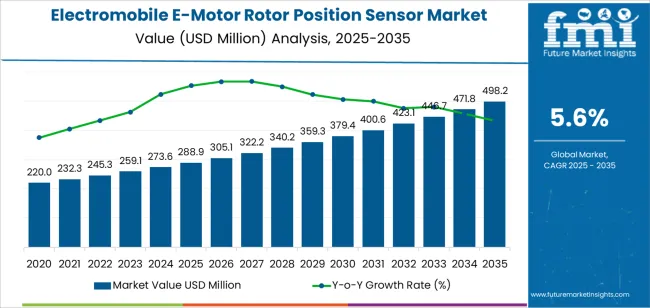
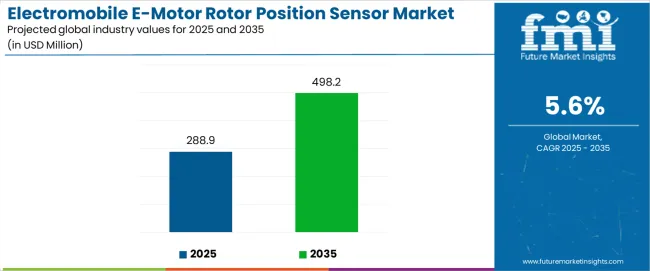
Electromobile E-Motor Rotor Position Sensor Market Key Takeaways
| Metric | Value |
|---|---|
| Estimated Value in (2025E) | USD 288.9 million |
| Forecast Value in (2035F) | USD 498.3 million |
| Forecast CAGR (2025 to 2035) | 5.6% |
Between 2025 and 2030, the electromobile e-motor rotor position sensor market is projected to expand from USD 288.9 million to USD 379.4 million, resulting in a value increase of USD 90.5 million, which represents 43.2% of the total forecast growth for the decade. This phase of development will be shaped by increasing adoption of electric vehicle technologies, rising demand for high-precision motor control systems, and growing emphasis on advanced sensing solutions with enhanced accuracy characteristics. Automotive manufacturers are expanding their electric vehicle capabilities to address the growing demand for efficient motor control applications, performance optimization, and next-generation powertrain requirements.
From 2030 to 2035, the market is forecast to grow from USD 379.4 million to USD 498.3 million, adding another USD 118.9 million, which constitutes 56.8% of the overall ten-year expansion. This period is expected to be characterized by the expansion of advanced motor control technologies, the integration of AI-powered sensing systems, and the development of multi-functional sensor platforms with enhanced precision capabilities. The growing adoption of electric vehicle platforms will drive demand for electromobile e-motor rotor position sensors with superior accuracy systems and compatibility with next-generation powertrain management software across automotive applications.
Between 2020 and 2025, the electromobile e-motor rotor position sensor market experienced robust growth, driven by increasing demand for electric vehicle technologies and growing recognition of precision sensing systems as essential components for efficient motor control across electric passenger vehicles, commercial electric transportation, and hybrid powertrain applications. The market developed as automotive manufacturers recognized the potential for advanced sensors to improve motor efficiency while maintaining performance effectiveness and enabling cost-effective control protocols. Technological advancement in magnetic sensing systems and precision measurement mechanisms began emphasizing the critical importance of maintaining rotational accuracy and speed detection consistency in diverse electric motor environments.
Market expansion is being supported by the increasing global demand for electric vehicle solutions and the corresponding need for automated systems that can provide superior motor control accuracy and operational efficiency while enabling reduced energy consumption and enhanced performance across various automotive electrification and transportation applications. Modern automotive operations and electric vehicle specialists are increasingly focused on implementing sensor technologies that can deliver precise motor control, prevent performance degradation, and provide consistent operational performance throughout complex driving conditions and diverse powertrain configurations. Electromobile e-motor rotor position sensors' proven ability to deliver exceptional precision for motor control applications, enable energy-efficient operations, and support cost-effective performance protocols make them essential components for contemporary electric vehicle and automotive electrification operations.
The growing emphasis on automotive electrification and energy efficiency is driving demand for electromobile e-motor rotor position sensors that can support electric vehicle requirements, improve powertrain performance outcomes, and enable automated control systems. Automotive manufacturers' preference for technology that combines effective motor control with operational reliability and energy efficiency is creating opportunities for innovative sensor implementations. The rising influence of electric mobility and precision motor control practices is also contributing to increased demand for electromobile e-motor rotor position sensors that can provide high-resolution position feedback, real-time monitoring capabilities, and reliable performance across extended operational periods.
The electromobile e-motor rotor position sensor market is poised for rapid growth and transformation. As industries across automotive, electric vehicles, commercial transportation, and motor control seek solutions that deliver exceptional sensing precision, operational reliability, and energy efficiency compliance, electromobile e-motor rotor position sensors are gaining prominence not just as specialized components but as strategic enablers of modern electric vehicle practices and motor control optimization.
Rising electric vehicle adoption in Asia-Pacific and expanding electrification initiatives globally amplify demand, while manufacturers are leveraging innovations in magnetic sensing systems, digital signal processing, and integrated control technologies.
Pathways like high-resolution sensing platforms, AI-powered motor control systems, and specialized automotive applications promise strong margin uplift, especially in electric vehicle segments. Geographic expansion and technology integration will capture volume, particularly where local automotive electrification and precision motor control adoption are critical. Regulatory support around automotive emissions reduction, electric vehicle promotion, and energy efficiency standards give structural support.
The market is segmented by type, application, resolution, end-use sector, and region. By type, the market is divided into shaft-end sensor and through axis sensor categories. By application, it covers passenger vehicle, commercial vehicle, industrial motors, and others. By resolution, the market includes high-resolution (≥16-bit), medium-resolution (12-16 bit), and standard-resolution (<12-bit) systems. By end-use sector, it is categorized into automotive manufacturers, tier-1 suppliers, aftermarket suppliers, and industrial motor manufacturers. Regionally, the market is divided into North America, Europe, East Asia, South Asia & Pacific, Latin America, and the Middle East & Africa.
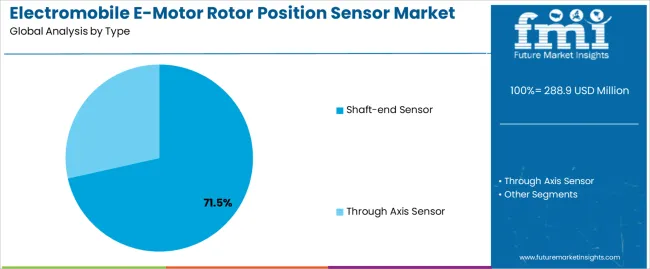
The shaft-end sensor segment is projected to account for 71.5% of the electromobile e-motor rotor position sensor market in 2025, reaffirming its position as the leading sensor type category. Electric vehicle manufacturers and automotive suppliers increasingly utilize shaft-end sensors for their superior installation convenience when operating across diverse motor configurations, excellent integration capabilities, and cost-effectiveness in applications ranging from passenger vehicle motors to commercial electric vehicle systems. Shaft-end sensor technology's advanced magnetic sensing capabilities and compact design characteristics directly address the automotive requirements for reliable position feedback in space-constrained electric motor environments.
This sensor type forms the foundation of modern electric vehicle operations, as it represents the sensing solution with the greatest installation flexibility and established market demand across multiple automotive categories and motor applications. Manufacturer investments in enhanced magnetic technologies and temperature stability continue to strengthen adoption among automotive manufacturers and electric vehicle producers. With companies prioritizing installation efficiency and cost optimization, shaft-end sensors align with both performance requirements and economic efficiency objectives, making them the central component of comprehensive electric vehicle sensing strategies.
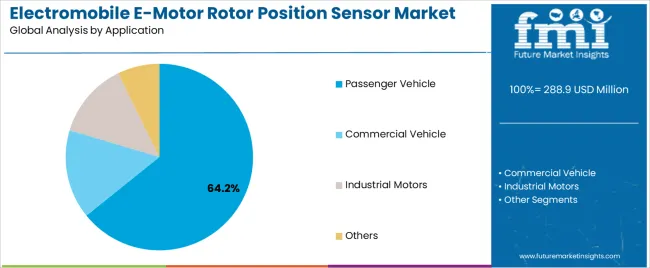
Passenger vehicle applications are projected to represent 64.2% of electromobile e-motor rotor position sensor demand in 2025, underscoring their critical role as the primary automotive consumers of precision sensor technology for motor control, powertrain management, and electric vehicle applications. Passenger vehicle manufacturers prefer electromobile e-motor rotor position sensors for their exceptional position accuracy capabilities, reliability characteristics, and ability to improve motor efficiency while ensuring effective control throughout diverse electric vehicle programs. Positioned as essential components for modern electric vehicle operations, electromobile e-motor rotor position sensors offer both performance advantages and energy efficiency benefits.
The segment is supported by continuous innovation in magnetic sensing technologies and the growing availability of specialized sensor systems that enable high-resolution position feedback with enhanced accuracy and rapid response capabilities. Additionally, passenger vehicle manufacturers are investing in integrated control systems to support comprehensive electric vehicle utilization and powertrain optimization. As electric vehicle demand becomes more prevalent and automotive efficiency requirements increase, passenger vehicle applications will continue to dominate the end-use market while supporting advanced automotive electrification utilization and motor control strategies.
The electromobile e-motor rotor position sensor market is advancing rapidly due to increasing demand for electric vehicle technologies and growing adoption of automated motor control solutions that provide superior position accuracy and operational reliability while enabling improved energy efficiency across diverse automotive electrification and motor control applications. However, the market faces challenges, including high precision requirements, electromagnetic interference concerns, and the need for specialized testing and validation programs. Innovation in digital signal processing capabilities and AI-powered sensing systems continues to influence product development and market expansion patterns.
Expansion of Digital Signal Processing and AI Technologies
The growing adoption of digital signal processing systems, AI-powered motor optimization algorithms, and machine learning-based control enhancement is enabling manufacturers to produce advanced electromobile e-motor rotor position sensors with superior accuracy capabilities, enhanced noise immunity, and automated calibration functionalities. Advanced digital processing systems provide improved position resolution while allowing more efficient motor control and consistent performance across various operating conditions and temperature ranges. Manufacturers are increasingly recognizing the competitive advantages of digital sensor capabilities for performance differentiation and premium market positioning.
Integration of Electric Vehicle Platforms and Advanced Motor Control
Modern electromobile e-motor rotor position sensor producers are incorporating high-voltage compatibility, integrated communication protocols, and advanced diagnostic systems to enhance operational intelligence, enable predictive maintenance capabilities, and deliver value-added solutions to automotive customers. These technologies improve electric vehicle efficiency while enabling new operational capabilities, including real-time performance monitoring, motor health tracking, and reduced maintenance overhead. Advanced system integration also allows manufacturers to support comprehensive electric vehicle platforms and automotive electrification beyond traditional mechanical sensing approaches.
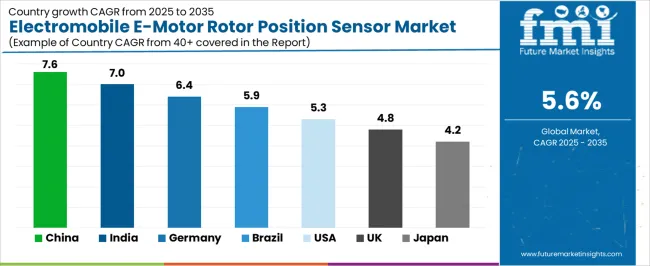
| Country | CAGR (2025 to 2035) |
|---|---|
| China | 7.6% |
| India | 7.0% |
| Germany | 6.4% |
| Brazil | 5.9% |
| USA | 5.3% |
| UK | 4.8% |
| Japan | 4.2% |
The electromobile e-motor rotor position sensor market is experiencing strong growth globally, with China leading at a 7.6% CAGR through 2035, driven by the expanding electric vehicle manufacturing programs, growing automotive electrification adoption, and significant investment in electric motor technology development. India follows at 7.0%, supported by government initiatives promoting electric vehicle adoption, increasing automotive manufacturing demand, and growing motor control requirements. Germany shows growth at 6.4%, emphasizing automotive technology innovation and advanced electric vehicle development. Brazil records 5.9%, focusing on automotive manufacturing expansion and electric vehicle adoption. The USA demonstrates 5.3% growth, prioritizing electric vehicle standards and automotive innovation excellence. The UK exhibits 4.8% growth, emphasizing automotive technology development and electric vehicle advancement. Japan shows 4.2% growth, supported by advanced automotive technology initiatives and precision motor control concentration.
The report covers an in-depth analysis of 40+ countries top-performing countries are highlighted below.
Revenue from electromobile e-motor rotor position sensors in China is projected to exhibit exceptional growth with a CAGR of 7.6% through 2035, driven by expanding electric vehicle manufacturing programs and rapidly growing automotive electrification adoption supported by government initiatives promoting electric mobility development. The country's strong position in electric vehicle production and increasing investment in motor control infrastructure are creating substantial demand for advanced electromobile e-motor rotor position sensor solutions. Major automotive manufacturers and electric vehicle producers are establishing comprehensive sensor integration capabilities to serve both domestic motor control demand and automotive efficiency markets.
Revenue from electromobile e-motor rotor position sensors in India is expanding at a CAGR of 7.0%, supported by the country's growing automotive manufacturing sector, expanding government support for electric vehicle adoption, and increasing utilization of advanced motor control solutions. The country's initiatives promoting automotive technology and growing manufacturer awareness are driving requirements for advanced motor control capabilities. International suppliers and domestic manufacturers are establishing extensive production and service capabilities to address the growing demand for electromobile e-motor rotor position sensor products.
Revenue from electromobile e-motor rotor position sensors in Germany is expanding at a CAGR of 6.4%, supported by the country's advanced automotive technology capabilities, strong emphasis on electric vehicle innovation, and robust demand for high-performance automotive components in motor control and electric vehicle applications. The nation's mature automotive sector and efficiency-focused operations are driving sophisticated electromobile e-motor rotor position sensor systems throughout the automotive industry. Leading manufacturers and technology providers are investing extensively in digital sensing systems and precision control technologies to serve both domestic and international markets.
Revenue from electromobile e-motor rotor position sensors in Brazil is growing at a CAGR of 5.9%, driven by the country's expanding automotive manufacturing sector, growing electric vehicle initiatives, and increasing investment in automotive technology development. Brazil's automotive industry growth and commitment to manufacturing modernization are supporting demand for efficient electromobile e-motor rotor position sensor solutions across multiple automotive segments. Manufacturers are establishing comprehensive service capabilities to serve the growing domestic market and automotive export opportunities.
Revenue from electromobile e-motor rotor position sensors in the USA is expanding at a CAGR of 5.3%, supported by the country's advanced automotive technology sector, strategic focus on electric vehicle development, and established automotive innovation capabilities. The USA's automotive technology leadership and system integration are driving demand for electromobile e-motor rotor position sensors in automotive manufacturing, electric vehicle production, and advanced motor control applications. Manufacturers are investing in comprehensive technology development to serve both domestic automotive markets and international specialty applications.
Revenue from electromobile e-motor rotor position sensors in the UK is growing at a CAGR of 4.8%, driven by the country's focus on automotive technology advancement, emphasis on electric vehicle development, and strong position in automotive innovation. The UK's established automotive technology capabilities and commitment to manufacturing modernization are supporting investment in advanced sensing technologies throughout major automotive regions. Industry leaders are establishing comprehensive technology integration systems to serve domestic automotive operations and specialty electric vehicle applications.
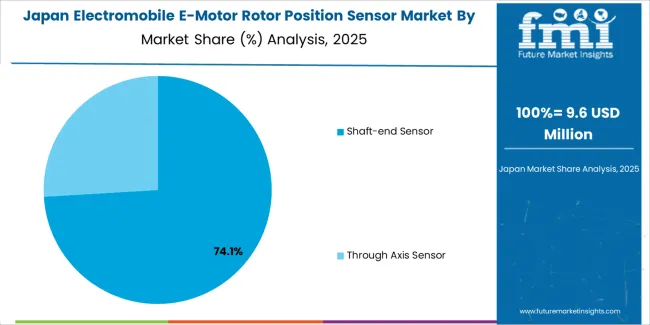
Revenue from electromobile e-motor rotor position sensors in Japan is expanding at a CAGR of 4.2%, supported by the country's advanced automotive technology initiatives, growing precision manufacturing sector, and strategic emphasis on automotive component development. Japan's automotive technology capabilities and integrated manufacturing systems are driving demand for advanced electromobile e-motor rotor position sensors in specialty automotive production, precision motor control, and high-performance automotive applications. Leading manufacturers are investing in specialized capabilities to serve the stringent requirements of advanced automotive technology and precision manufacturing industries.
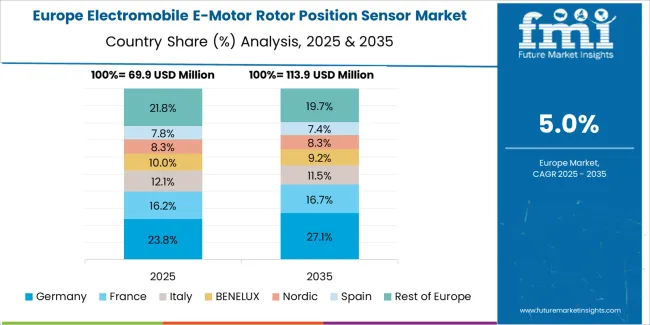
The electromobile e-motor rotor position sensor market in Europe is projected to grow from USD 57.8 million in 2025 to USD 99.7 million by 2035, registering a CAGR of 5.6% over the forecast period. Germany is expected to maintain its leadership position with a 38.5% market share in 2025, declining slightly to 38.1% by 2035, supported by its strong automotive technology sector, advanced electric vehicle capabilities, and comprehensive automotive manufacturing industry serving diverse electromobile e-motor rotor position sensor applications across Europe.
France follows with a 19.2% share in 2025, projected to reach 19.6% by 2035, driven by robust demand for electromobile e-motor rotor position sensors in automotive manufacturing, electric vehicle development programs, and precision motor control applications, combined with established automotive technology infrastructure and component expertise. The United Kingdom holds a 15.8% share in 2025, expected to reach 16.1% by 2035, supported by strong automotive technology sector and growing electric vehicle activities. Italy commands a 11.5% share in 2025, projected to reach 11.8% by 2035, while Spain accounts for 8.7% in 2025, expected to reach 9.0% by 2035. The Netherlands maintains a 4.2% share in 2025, growing to 4.3% by 2035. The Rest of Europe region, including Nordic countries, Eastern Europe, Belgium, Poland, and other nations, is anticipated to maintain momentum, with its collective share moving from 2.1% to 1.1% by 2035, attributed to increasing automotive modernization in Eastern Europe and growing electric vehicle penetration in Nordic countries implementing advanced automotive technology programs.
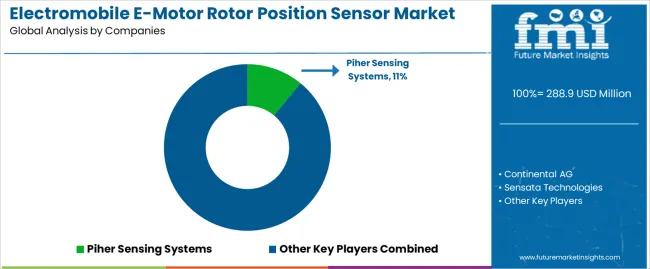
The electromobile e-motor rotor position sensor market is characterized by competition among established sensor manufacturers, specialized automotive component producers, and integrated electric vehicle solutions providers. Companies are investing in magnetic sensing technology research, resolution optimization, precision control system development, and comprehensive product portfolios to deliver consistent, high-performance, and application-specific electromobile e-motor rotor position sensor solutions. Innovation in digital signal processing systems, temperature compensation, and operational reliability enhancement is central to strengthening market position and competitive advantage.
Piher Sensing Systems leads the market with a strong market share, offering comprehensive electromobile e-motor rotor position sensor solutions including advanced magnetic sensing systems with a focus on automotive and electric vehicle applications. Continental AG provides specialized automotive sensor capabilities with an emphasis on precision motor control systems and automated vehicle operations. Sensata Technologies delivers innovative sensing products with a focus on high-resolution platforms and commercial automotive services. TE Connectivity specializes in automotive connectivity and sensor technologies for electric vehicle applications. EFI Automotive focuses on precision automotive components and integrated motor control solutions. TDK Electronics offers specialized sensor platforms with emphasis on commercial automotive and industrial motor applications.
Key Players in the Electromobile E-Motor Rotor Position Sensor Market
| Items | Values |
|---|---|
| Quantitative Units (2025) | USD 288.9 million |
| Type | Shaft-end Sensor, Through Axis Sensor |
| Application | Passenger Vehicle, Commercial Vehicle, Industrial Motors, Others |
| Resolution | High-Resolution (≥16-bit), Medium-Resolution (12-16 bit), Standard-Resolution (<12-bit) |
| End-Use Sector | Automotive Manufacturers, Tier-1 Suppliers, Aftermarket Suppliers, Industrial Motor Manufacturers |
| Regions Covered | North America, Europe, East Asia, South Asia & Pacific, Latin America, Middle East & Africa |
| Countries Covered | China, India, Germany, Brazil, United States, United Kingdom, Japan and 40+ countries |
| Key Companies Profiled | Piher Sensing Systems, Continental AG, Sensata Technologies, TE Connectivity, and EFI Automotive |
| Additional Attributes | Dollar sales by type and application category, regional demand trends, competitive landscape, technological advancements in digital signal processing systems, magnetic sensing development, AI integration innovation, and automotive system integration |
The global electromobile e-motor rotor position sensor market is estimated to be valued at USD 288.9 million in 2025.
The market size for the electromobile e-motor rotor position sensor market is projected to reach USD 498.2 million by 2035.
The electromobile e-motor rotor position sensor market is expected to grow at a 5.6% CAGR between 2025 and 2035.
The key product types in electromobile e-motor rotor position sensor market are shaft-end sensor and through axis sensor.
In terms of application, passenger vehicle segment to command 64.2% share in the electromobile e-motor rotor position sensor market in 2025.






Full Research Suite comprises of:
Market outlook & trends analysis
Interviews & case studies
Strategic recommendations
Vendor profiles & capabilities analysis
5-year forecasts
8 regions and 60+ country-level data splits
Market segment data splits
12 months of continuous data updates
DELIVERED AS:
PDF EXCEL ONLINE
Sensor Fusion Market Size and Share Forecast Outlook 2025 to 2035
Sensor Based Glucose Measuring Systems Market Size and Share Forecast Outlook 2025 to 2035
Sensor Development Kit Market Size and Share Forecast Outlook 2025 to 2035
Sensory Modifier Market Size and Share Forecast Outlook 2025 to 2035
Sensor Bearings Market Insights - Growth & Forecast 2025 to 2035
Sensor Hub Market Analysis - Growth, Demand & Forecast 2025 to 2035
Sensor Patches Market Analysis - Growth, Applications & Outlook 2025 to 2035
Sensors Market Analysis by Type, Technology, End User & Region - Forecast from 2025 to 2035
Sensor Data Analytics Market Growth - Trends & Forecast through 2034
Sensor Testing Market Analysis – Growth & Forecast 2024-2034
Sensor Cable Market
Sensormatic Labels Market
3D Sensor Market Size and Share Forecast Outlook 2025 to 2035
Biosensors Market Trends – Growth & Future Outlook 2025 to 2035
UV Sensors Market Analysis by Type, End User, and Region from 2025 to 2035
CP Sensor for Consumer Applications Market – Growth & Forecast 2025 to 2035
Nanosensors Market Size and Share Forecast Outlook 2025 to 2035
NOx Sensor Market Size and Share Forecast Outlook 2025 to 2035
VOC Sensors and Monitors Market Analysis - Size, Growth, and Forecast 2025 to 2035
Rain Sensors Market Size and Share Forecast Outlook 2025 to 2035

Thank you!
You will receive an email from our Business Development Manager. Please be sure to check your SPAM/JUNK folder too.
Chat With
MaRIA